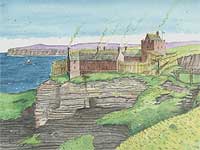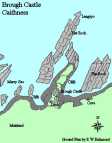 | Introduction | The Castles | Images | Links | History Of Caithness | Glossary | A to Z of Caithness |
• Reconstruction Paintings • Ground Plans • Area Plans • Photo Galleries • Non-Caithness Castles Paintings |
| Brough Castle, Caithness Map Ref: ND 228740 Landranger Sheet 12 Brough Castle Site From The Air Introduction
Whilst we have been unable to find any documentary evidence on the history of the castle it is noticeable that it is identical in size and arrangement to the Castle of Old Wick, both of which took the form of a large plain keep rising out of the edge of the ditch giving protection to two ranges of buildings behind it and the whole being enclosed with a barmkin wall. The "Old Man" however also had a forward gatehouse and a second ditch which is not the case here. In the absence of any documented history of the castle so far, it is not possible to give an accurate date for its construction but from the layout features and its likeness to the Castle of Old Wick it is likely to have been built in the early 14th century and may have been an early stronghold of the Cheyne family. Unfortunately the castle has been heavily robbed of its stone, a sad fate of many of these fine strongholds in Caithness and we are left to speculate what it must have looked like and to whom it belonged. It may be that some of its history will come to light as a result of these Caithness pages and we would be pleased to hear from anyone with any further information. In the meantime Andrew Spratt's reconstruction, which is based on a foundation layout of the site and the "Old Man", is probably as close as we'll get in the meantime to how it must have looked. References:
|








